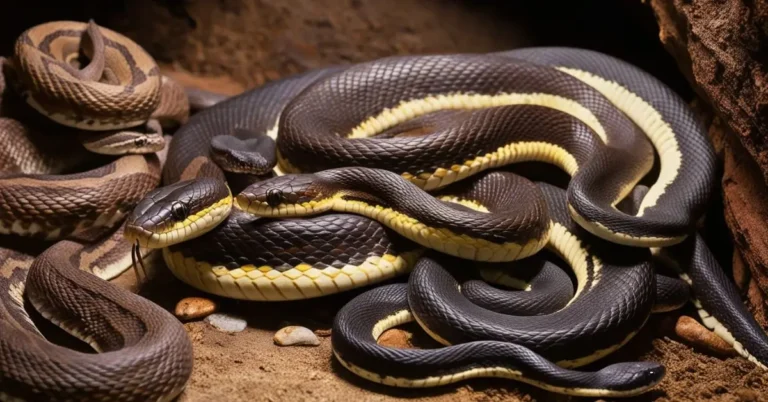Snakes have long fascinated humans, both as symbols of mystery and power and as creatures of fear. One of the common perceptions surrounding snakes is the notion of a “snake nest”—an image that invokes scenes of writhing serpents huddled together in hidden underground lairs. While this portrayal has fueled countless myths and misconceptions, the reality of snake nesting habits is more varied and ecologically significant than often understood. In this article, we’ll explore the concept of snake nests in depth, examining how different snake species reproduce, where they lay eggs or give birth, and the role these nests play in their ecosystems.
Understanding Snake Reproduction: Eggs or Live Birth?
Before delving into the specifics of snake nests, it’s crucial to understand the two primary reproductive strategies snakes employ: oviparity (egg-laying) and viviparity (live birth).
Oviparous Snakes: Egg-Laying Species
Most snakes, including species like pythons, king snakes, and rat snakes, are oviparous, meaning they reproduce by laying eggs. These snakes require specific environmental conditions to ensure the successful incubation of their eggs. Oviparous snakes typically seek out secluded and secure locations to build their nests, often choosing places with optimal temperature and humidity levels.
Some common nesting sites for oviparous snakes include:
- Abandoned burrows: Snakes may use the burrows of other animals as a safe and warm spot to lay their eggs.
- Rotting vegetation: Decomposing plant material generates heat as it breaks down, creating a natural incubator for snake eggs.
- Underground crevices or beneath logs: These areas provide a stable, controlled environment away from predators and environmental extremes.
While most oviparous snake species do not exhibit parental care after laying eggs, certain species, such as the female python, will actively guard their nest until the eggs hatch. Pythons may coil around their eggs, providing protection and regulating their temperature through muscular contractions.
Viviparous Snakes: Live-Bearing Species
In contrast to oviparous snakes, viviparous species give birth to live young. Some of the most well-known examples of viviparous snakes include boas, vipers, and certain species of water snakes. These snakes do not create traditional nests in the way oviparous species do, as they carry their developing embryos internally.
Viviparous snakes often give birth in safe, concealed areas that provide protection from predators. For instance, they may choose secluded rocks, dense vegetation, or burrows as birthing spots. Once the young are born, they are generally left to fend for themselves, as snake parents—whether viviparous or oviparous—do not typically engage in extended parental care.
Snake Nesting Behavior Across Different Species
Python Nests: A Rare Case of Parental Care
Among oviparous snakes, pythons are remarkable for the level of parental care they provide to their eggs. Female pythons will locate a secure nesting site, often in a shallow burrow or within dense vegetation, and lay their eggs there. Unlike most other snake species, the python does not simply abandon the nest after laying eggs. Instead, she remains with the eggs, coiling around them to offer protection and regulate the temperature of the clutch.
Pythons utilize muscular contractions to generate heat, helping to keep the eggs warm in cooler environments. This unique behavior—sometimes referred to as “shivering thermogenesis”—demonstrates the maternal investment pythons provide to their offspring. After the eggs hatch, the young pythons disperse on their own, with no further assistance from the mother.
Garter Snakes: Communal Nesting
In contrast to solitary nest-building species, certain species of snakes engage in communal nesting behaviors. Garter snakes (genus Thamnophis), found across North America, are known for their tendency to form large groups, particularly during the winter months when they gather in dens to hibernate. This phenomenon is known as brumation—a state of dormancy that snakes and other reptiles enter to survive colder temperatures.
While these dens are not “nests” in the reproductive sense, they can hold dozens or even hundreds of snakes at a time. When the weather warms up, garter snakes emerge from their dens and spread out to forage and mate. Some species of garter snakes may also use communal nesting sites to lay their eggs in areas with ideal conditions for incubation.
Rattlesnakes: Hibernacula and Nursery Sites
Rattlesnakes, members of the Crotalus genus, are another species known for using communal dens, referred to as hibernacula, during the winter months. These dens are often located in rocky crevices, underground burrows, or other sheltered environments that provide stable temperatures and protection from the elements. While hibernacula are primarily for overwintering, they also serve as key sites for snake reproduction.
Female rattlesnakes, which are viviparous, give birth to live young in these hibernacula or nearby nursery sites during the late summer or early fall. The young rattlesnakes, known as neonates, remain near the mother for a short period after birth before dispersing into the surrounding environment.
Do Snakes Build Nests?
The term “snake nest” is often misunderstood. While some snake species do actively seek out and modify environments to create a nesting site for their eggs, most snakes do not build elaborate nests in the way birds or mammals might. Instead, they rely on naturally occurring environmental features such as burrows, rock crevices, or decomposing vegetation to provide the necessary conditions for reproduction.
Moreover, the misconception that snakes gather in large, tangled nests stems from the sight of snakes congregating in hibernacula or other communal spaces. In reality, most snake species are solitary creatures outside of the mating season or hibernation period.
The Ecological Importance of Snake Nests
Snake nests, whether in the form of egg-laying sites or communal hibernacula, play a vital role in maintaining the health and balance of ecosystems. Here are several ways in which snake nesting behaviors contribute to broader ecological processes:
1. Pest Control
Snakes are natural predators of many pests, including rodents, insects, and other small animals. By maintaining healthy populations of snakes, ecosystems benefit from natural pest control. A single snake may consume dozens of rodents or other pests in a single year, helping to prevent population explosions that could harm crops, spread diseases, or disturb local flora and fauna.
2. Prey for Other Species
While snakes are efficient predators, they are also prey for a variety of animals, including birds of prey, mammals, and even other snakes. Snake eggs, in particular, are a valuable food source for many predators such as raccoons, foxes, and certain bird species. The presence of snake nests in an ecosystem supports a complex web of predator-prey interactions that helps maintain biodiversity.
3. Soil Aeration and Nutrient Cycling
In some cases, snake nests can contribute to soil aeration and nutrient cycling. For example, snakes that use burrows to lay their eggs or give birth may help to aerate the soil, improving its structure and promoting the growth of plants. Additionally, decomposing snake eggs or discarded skins left near nesting sites can return nutrients to the soil, enriching the surrounding ecosystem.
4. Indicators of Environmental Health
Snake populations, including their nesting sites, can serve as indicators of environmental health. Because snakes are ectothermic (relying on external sources of heat to regulate their body temperature), they are highly sensitive to changes in temperature, humidity, and habitat quality. A decline in snake populations, or a disruption to their nesting behavior, may signal broader environmental issues such as habitat loss, climate change, or pollution.
Human-Snake Interactions: Myths and Misunderstandings
The concept of a “snake nest” has fueled many myths and misunderstandings about these creatures. One common myth is the idea that large numbers of venomous snakes gather in hidden nests, ready to attack unsuspecting humans. In reality, snakes are generally shy and avoid human contact whenever possible. While some species may congregate in communal dens for hibernation or reproduction, these gatherings are driven by survival needs, not aggression.
Another misconception is the belief that snakes actively protect their nests or young in the same way that birds or mammals do. While certain species, such as pythons, exhibit some level of maternal care, most snakes do not guard their nests after laying eggs. Instead, they rely on the environment to provide the necessary conditions for successful hatching.
Conservation and Protection of Snake Habitats
As with many other wildlife species, snake populations are facing increasing pressure from habitat destruction, climate change, and human activity. The loss of suitable nesting sites—whether due to deforestation, urban development, or agricultural expansion—can have a significant impact on snake populations and the ecosystems they help to maintain.
Conservation efforts aimed at protecting snake habitats, including nesting and hibernation sites, are critical for preserving biodiversity and ensuring the long-term survival of these important reptiles. In some cases, conservation programs may involve creating artificial nesting sites or hibernacula to support declining snake populations. Public education and awareness campaigns can also help dispel myths about snakes and promote coexistence between humans and these often-misunderstood creatures.
Conclusion
Snake nests, while often shrouded in mystery and misconception, are a fascinating aspect of reptilian biology. From the egg-laying habits of oviparous species to the communal dens used by viviparous snakes, these nesting behaviors play a crucial role in the life cycles of snakes and the health of ecosystems. Understanding the realities of snake nesting, as well as the ecological significance of these behaviors, can help promote a greater appreciation for these remarkable reptiles and the environments they inhabit.
As we continue to learn more about snake ecology and behavior, it’s clear that protecting their habitats—especially their nesting and hibernation sites—will be essential for the conservation of these species and the broader ecosystems they support. By debunking myths and fostering a deeper understanding of snake nests, we can work towards a more harmonious coexistence with these vital members of the natural world.

